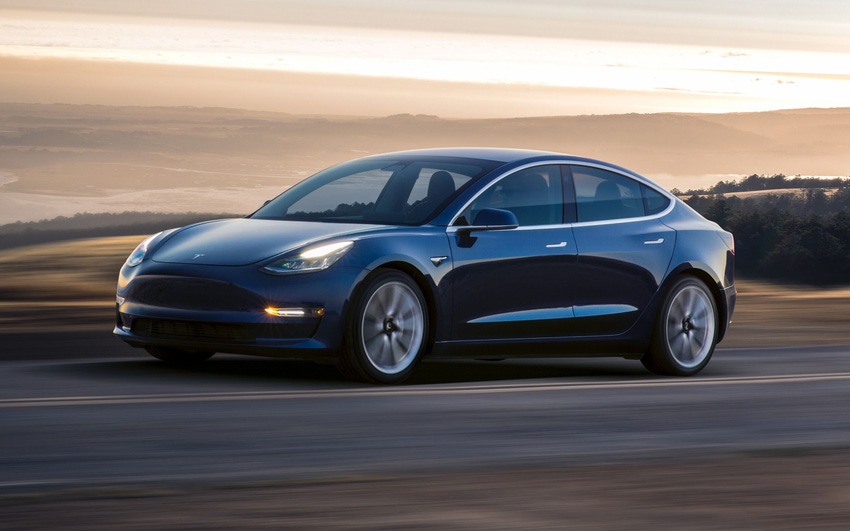Worldwide EV battery production will increase by 45% in 2018, but growth could be better if Tesla’s Model 3 sells in big numbers.
December 28, 2017

Electric vehicle battery production will rise in 2018, but the degree to which it rises will depend largely on two wild card factors – China and the Tesla Model 3.
If China continues its government push to sell more electric vehicles, and if Tesla climbs out of its so-called “production hell,” the increases could be big. If neither happens, the battery industry will still see a healthy percentage growth, but one based on small overall volumes.
“It could be a high percentage gain,” noted Brett Smith, an assistant director the Center for Automotive Research and a speaker at the upcoming ADM Cleveland Conference. “But a high percentage of a small number is still a small number.”
Lux Research, Inc. is predicting that worldwide EV battery production will jump to 35 GWh in 2018, an increase of 45% over 2017. About 87% of that total is expected to come from pure electric cars with big battery packs. The remainder will come from plug-in hybrids, the company said. “2018 is going to be the biggest year ever in terms of plug-in battery demand, as pretty much every year has been,” noted Christopher Robinson, an industry analyst for Lux.
Still, the starting point is a small number, and the unknowns are admittedly huge, analysts said. In 2016, plug-in cars represented only 0.9% of the 17.5 million vehicles sold in the US, and battery-electrics were just half of that figure, according to sales numbers from the website, Inside EVs. Sales are expected to crack the 1% mark in 2017, but that, too, falls far short of the industry’s ultimate hopes for the technology.
Tesla, Inc., however, could change all that. Earlier this year, CEO Elon Musk made grand predictions for the company’s moderately priced, Model 3 electric sedan. He called for 1,000 a week to be produced in July, 2,000 a week in August, 4,000 a week in September, 5,000 a week by the end of 2017, and 10,000 a week by the end of 2018.
|
If Tesla emerges from its “production hell,” sales of the moderately-priced Model 3 could have a profound effect on battery demand in 2018. (Source: Tesla, Inc.) |
The reality has been quite different than the predictions, however, with the company selling a cumulative total of just 712 vehicles by the end of November, according to Inside EVs. Musk has blamed that on supply and production snafus – a phenomenon he referred to as “production hell.”
Most analysts expect the issues to be resolved soon, but they still wonder whether the market will embrace the technology as Musk hopes. “We really have no clue,” Smith told us. “The Model 3 could be a blip on the radar or it could be something big.”
If it emerges as “something big,” Tesla’s new vehicle could have a profound effect on worldwide battery production, analysts said. “Early indications are that Tesla is going to be selling the higher-priced, 300-mile-range models first,” Robinson said. “Those batteries are expected to be big – about 65-70 kWh. So when they start selling thousands of those a week, there’s going to be a big impact on battery demand.”
|
This article is part of Design News’ 2018 Look Ahead package, offering perspective and insight on 10 areas of advancing engineering. Before you dive too deeply into 2018, prepare yourself for what will surely be an innovative new year with Design News’ 2018 Look Ahead articles. |
China, the Great Unknown
The Model 3’s impact might not be nearly as great as that of China, however. In 2017, China will sell more than twice as many EVs as the US, totaling almost half of all EV sales around the world. And that number could grow in 2018.
The key to that growth lies in the country’s EV policies and regulations. Local and central governments have reportedly allotted subsidies worth up to about $15,000 per vehicle, according to a recent article in the Financial Times. Moreover, Chinese consumers in large population centers have little chance of obtaining license plates for new gas-burning cars, creating a mandate of sorts for EVs, The Wall Street Journal recently reported.
“The success of the electric vehicle right now depends on whether you have top-down management or bottom-up management,” Smith said. “In regions where the government can tell you what to do, electric vehicle sales will be better. In regions where the consumer decides, you’re probably going to see a lot slower uptake of electric vehicles.”
Because China temporarily constrained its subsidies early this year, however, no one is sure if the country will maintain its course. Its policies are likely to be costly, not only for the government, but for manufacturers and consumers, as well. If the country stays the course and sets regulations to stop the sale of gasoline-based vehicles by some future date, as some predict, worldwide battery production will soar, analysts say.
Still, China’s future plans are difficult to predict, analysts said. “Will they have the commitment to get through the valley of lost profit?" Smith asked. “No one knows.”
Read More Articles on Automotive Technology
Survey Shows American Brands Trail Asians, Europeans in Reliability
Tesla Debuts Electric Beast Semi Truck
The Ten Least Reliable Automotive Brands
10 of History's Greatest American Pickup Trucks
12 Vehicle Infotainment Systems That Distract Drivers
GM to Produce 20 New Electric Cars by 2023
Senior technical editor Chuck Murray has been writing about technology for 33 years. He joined Design News in 1987, and has covered electronics, automation, fluid power, and auto.
About the Author(s)
You May Also Like





